PONTIAC SOLSTICE 2008 Owners Manual
Manufacturer: PONTIAC, Model Year: 2008, Model line: SOLSTICE, Model: PONTIAC SOLSTICE 2008Pages: 348, PDF Size: 5.23 MB
Page 171 of 348
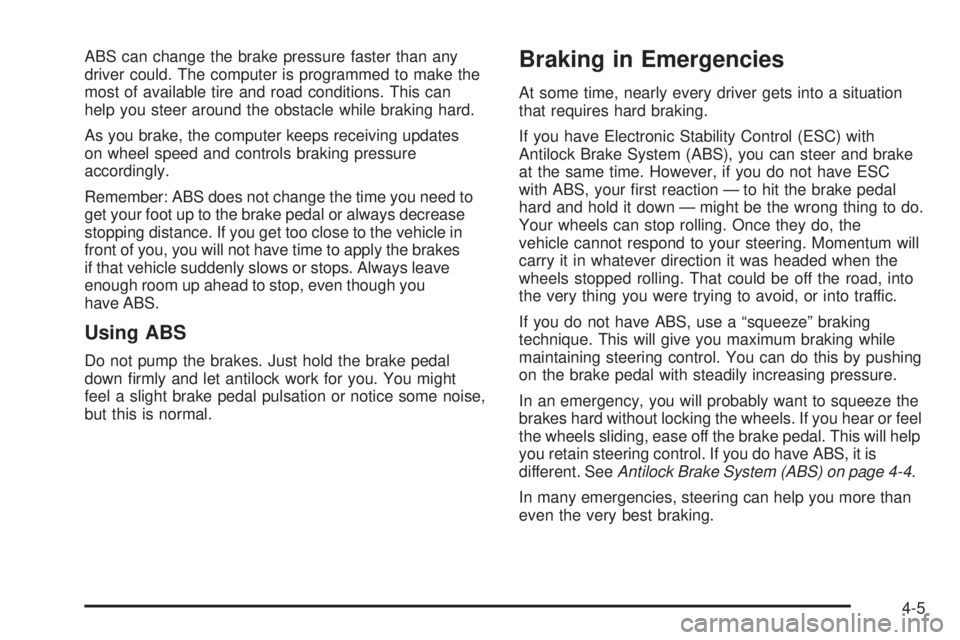
ABS can change the brake pressure faster than any
driver could. The computer is programmed to make the
most of available tire and road conditions. This can
help you steer around the obstacle while braking hard.
As you brake, the computer keeps receiving updates
on wheel speed and controls braking pressure
accordingly.
Remember: ABS does not change the time you need to
get your foot up to the brake pedal or always decrease
stopping distance. If you get too close to the vehicle in
front of you, you will not have time to apply the brakes
if that vehicle suddenly slows or stops. Always leave
enough room up ahead to stop, even though you
have ABS.
Using ABS
Do not pump the brakes. Just hold the brake pedal
down �rmly and let antilock work for you. You might
feel a slight brake pedal pulsation or notice some noise,
but this is normal.
Braking in Emergencies
At some time, nearly every driver gets into a situation
that requires hard braking.
If you have Electronic Stability Control (ESC) with
Antilock Brake System (ABS), you can steer and brake
at the same time. However, if you do not have ESC
with ABS, your �rst reaction — to hit the brake pedal
hard and hold it down — might be the wrong thing to do.
Your wheels can stop rolling. Once they do, the
vehicle cannot respond to your steering. Momentum will
carry it in whatever direction it was headed when the
wheels stopped rolling. That could be off the road, into
the very thing you were trying to avoid, or into traffic.
If you do not have ABS, use a “squeeze” braking
technique. This will give you maximum braking while
maintaining steering control. You can do this by pushing
on the brake pedal with steadily increasing pressure.
In an emergency, you will probably want to squeeze the
brakes hard without locking the wheels. If you hear or feel
the wheels sliding, ease off the brake pedal. This will help
you retain steering control. If you do have ABS, it is
different. SeeAntilock Brake System (ABS) on page 4-4.
In many emergencies, steering can help you more than
even the very best braking.
4-5
Page 172 of 348
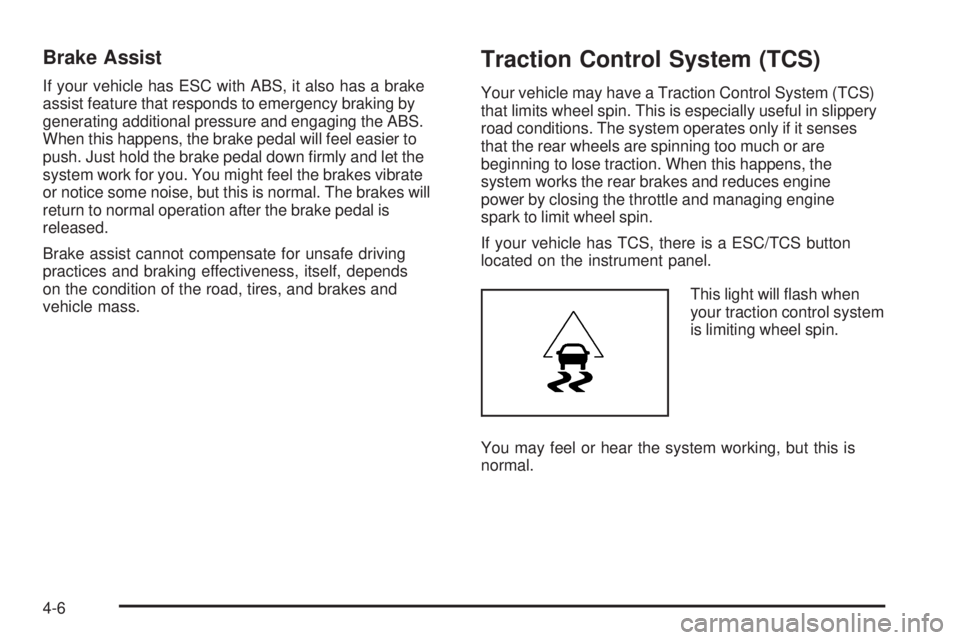
Brake Assist
If your vehicle has ESC with ABS, it also has a brake
assist feature that responds to emergency braking by
generating additional pressure and engaging the ABS.
When this happens, the brake pedal will feel easier to
push. Just hold the brake pedal down �rmly and let the
system work for you. You might feel the brakes vibrate
or notice some noise, but this is normal. The brakes will
return to normal operation after the brake pedal is
released.
Brake assist cannot compensate for unsafe driving
practices and braking effectiveness, itself, depends
on the condition of the road, tires, and brakes and
vehicle mass.
Traction Control System (TCS)
Your vehicle may have a Traction Control System (TCS)
that limits wheel spin. This is especially useful in slippery
road conditions. The system operates only if it senses
that the rear wheels are spinning too much or are
beginning to lose traction. When this happens, the
system works the rear brakes and reduces engine
power by closing the throttle and managing engine
spark to limit wheel spin.
If your vehicle has TCS, there is a ESC/TCS button
located on the instrument panel.
This light will �ash when
your traction control system
is limiting wheel spin.
You may feel or hear the system working, but this is
normal.
4-6
Page 173 of 348
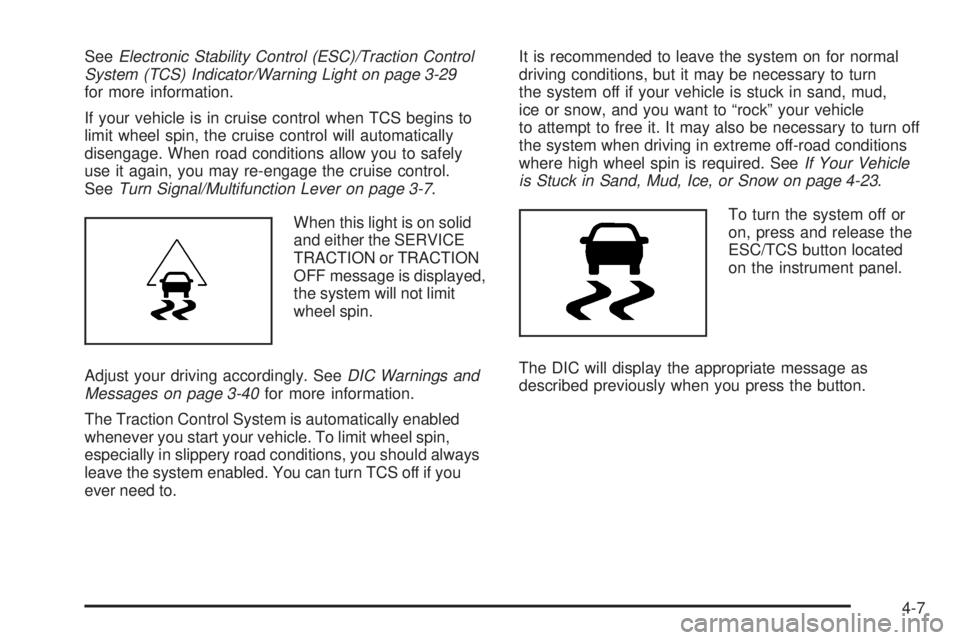
SeeElectronic Stability Control (ESC)/Traction Control
System (TCS) Indicator/Warning Light on page 3-29
for more information.
If your vehicle is in cruise control when TCS begins to
limit wheel spin, the cruise control will automatically
disengage. When road conditions allow you to safely
use it again, you may re-engage the cruise control.
SeeTurn Signal/Multifunction Lever on page 3-7.
When this light is on solid
and either the SERVICE
TRACTION or TRACTION
OFF message is displayed,
the system will not limit
wheel spin.
Adjust your driving accordingly. SeeDIC Warnings and
Messages on page 3-40for more information.
The Traction Control System is automatically enabled
whenever you start your vehicle. To limit wheel spin,
especially in slippery road conditions, you should always
leave the system enabled. You can turn TCS off if you
ever need to.It is recommended to leave the system on for normal
driving conditions, but it may be necessary to turn
the system off if your vehicle is stuck in sand, mud,
ice or snow, and you want to “rock” your vehicle
to attempt to free it. It may also be necessary to turn off
the system when driving in extreme off-road conditions
where high wheel spin is required. SeeIf Your Vehicle
is Stuck in Sand, Mud, Ice, or Snow on page 4-23.
To turn the system off or
on, press and release the
ESC/TCS button located
on the instrument panel.
The DIC will display the appropriate message as
described previously when you press the button.
4-7
Page 174 of 348
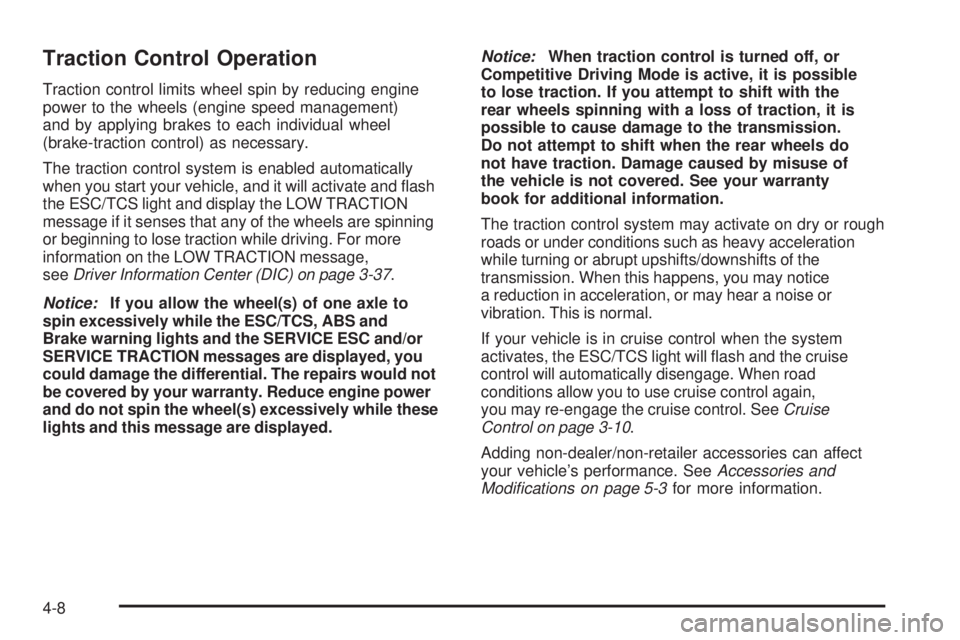
Traction Control Operation
Traction control limits wheel spin by reducing engine
power to the wheels (engine speed management)
and by applying brakes to each individual wheel
(brake-traction control) as necessary.
The traction control system is enabled automatically
when you start your vehicle, and it will activate and �ash
the ESC/TCS light and display the LOW TRACTION
message if it senses that any of the wheels are spinning
or beginning to lose traction while driving. For more
information on the LOW TRACTION message,
seeDriver Information Center (DIC) on page 3-37.
Notice:If you allow the wheel(s) of one axle to
spin excessively while the ESC/TCS, ABS and
Brake warning lights and the SERVICE ESC and/or
SERVICE TRACTION messages are displayed, you
could damage the differential. The repairs would not
be covered by your warranty. Reduce engine power
and do not spin the wheel(s) excessively while these
lights and this message are displayed.Notice:When traction control is turned off, or
Competitive Driving Mode is active, it is possible
to lose traction. If you attempt to shift with the
rear wheels spinning with a loss of traction, it is
possible to cause damage to the transmission.
Do not attempt to shift when the rear wheels do
not have traction. Damage caused by misuse of
the vehicle is not covered. See your warranty
book for additional information.
The traction control system may activate on dry or rough
roads or under conditions such as heavy acceleration
while turning or abrupt upshifts/downshifts of the
transmission. When this happens, you may notice
a reduction in acceleration, or may hear a noise or
vibration. This is normal.
If your vehicle is in cruise control when the system
activates, the ESC/TCS light will �ash and the cruise
control will automatically disengage. When road
conditions allow you to use cruise control again,
you may re-engage the cruise control. SeeCruise
Control on page 3-10.
Adding non-dealer/non-retailer accessories can affect
your vehicle’s performance. SeeAccessories and
Modifications on page 5-3for more information.
4-8
Page 175 of 348
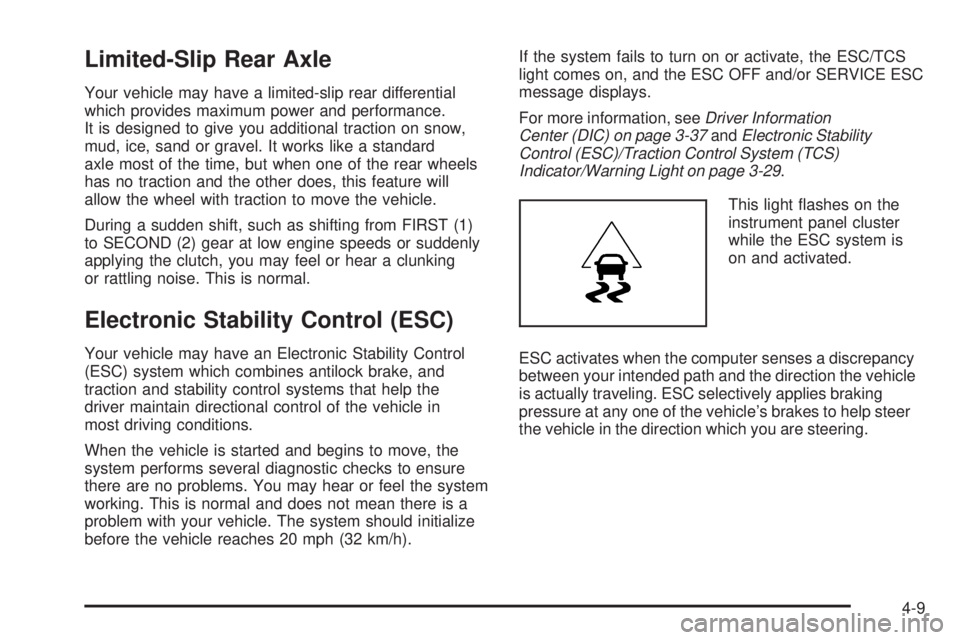
Limited-Slip Rear Axle
Your vehicle may have a limited-slip rear differential
which provides maximum power and performance.
It is designed to give you additional traction on snow,
mud, ice, sand or gravel. It works like a standard
axle most of the time, but when one of the rear wheels
has no traction and the other does, this feature will
allow the wheel with traction to move the vehicle.
During a sudden shift, such as shifting from FIRST (1)
to SECOND (2) gear at low engine speeds or suddenly
applying the clutch, you may feel or hear a clunking
or rattling noise. This is normal.
Electronic Stability Control (ESC)
Your vehicle may have an Electronic Stability Control
(ESC) system which combines antilock brake, and
traction and stability control systems that help the
driver maintain directional control of the vehicle in
most driving conditions.
When the vehicle is started and begins to move, the
system performs several diagnostic checks to ensure
there are no problems. You may hear or feel the system
working. This is normal and does not mean there is a
problem with your vehicle. The system should initialize
before the vehicle reaches 20 mph (32 km/h).If the system fails to turn on or activate, the ESC/TCS
light comes on, and the ESC OFF and/or SERVICE ESC
message displays.
For more information, seeDriver Information
Center (DIC) on page 3-37andElectronic Stability
Control (ESC)/Traction Control System (TCS)
Indicator/Warning Light on page 3-29.
This light �ashes on the
instrument panel cluster
while the ESC system is
on and activated.
ESC activates when the computer senses a discrepancy
between your intended path and the direction the vehicle
is actually traveling. ESC selectively applies braking
pressure at any one of the vehicle’s brakes to help steer
the vehicle in the direction which you are steering.
4-9
Page 176 of 348
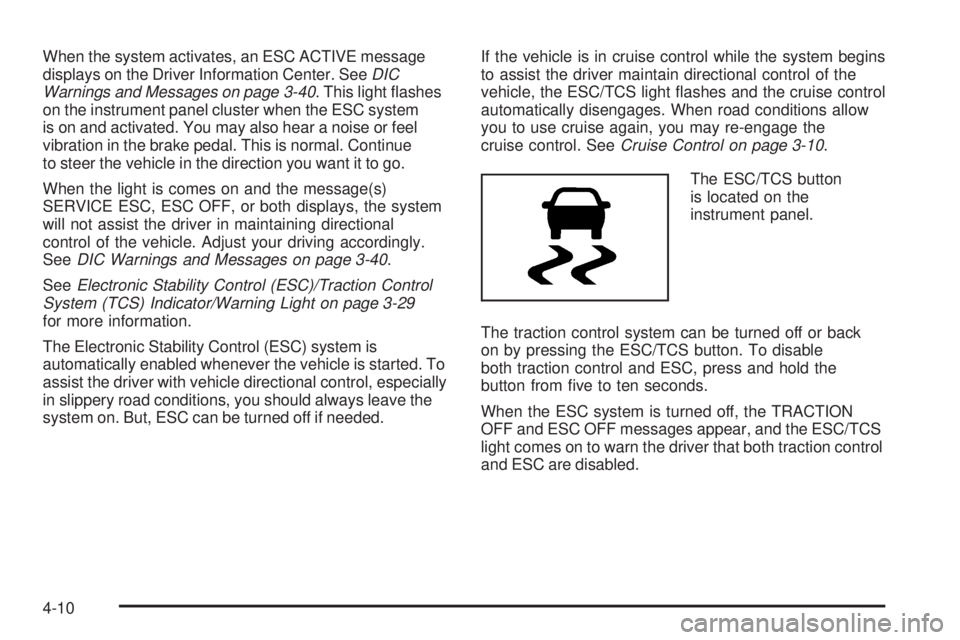
When the system activates, an ESC ACTIVE message
displays on the Driver Information Center. SeeDIC
Warnings and Messages on page 3-40. This light �ashes
on the instrument panel cluster when the ESC system
is on and activated. You may also hear a noise or feel
vibration in the brake pedal. This is normal. Continue
to steer the vehicle in the direction you want it to go.
When the light is comes on and the message(s)
SERVICE ESC, ESC OFF, or both displays, the system
will not assist the driver in maintaining directional
control of the vehicle. Adjust your driving accordingly.
SeeDIC Warnings and Messages on page 3-40.
SeeElectronic Stability Control (ESC)/Traction Control
System (TCS) Indicator/Warning Light on page 3-29
for more information.
The Electronic Stability Control (ESC) system is
automatically enabled whenever the vehicle is started. To
assist the driver with vehicle directional control, especially
in slippery road conditions, you should always leave the
system on. But, ESC can be turned off if needed.If the vehicle is in cruise control while the system begins
to assist the driver maintain directional control of the
vehicle, the ESC/TCS light �ashes and the cruise control
automatically disengages. When road conditions allow
you to use cruise again, you may re-engage the
cruise control. SeeCruise Control on page 3-10.
The ESC/TCS button
is located on the
instrument panel.
The traction control system can be turned off or back
on by pressing the ESC/TCS button. To disable
both traction control and ESC, press and hold the
button from �ve to ten seconds.
When the ESC system is turned off, the TRACTION
OFF and ESC OFF messages appear, and the ESC/TCS
light comes on to warn the driver that both traction control
and ESC are disabled.
4-10
Page 177 of 348
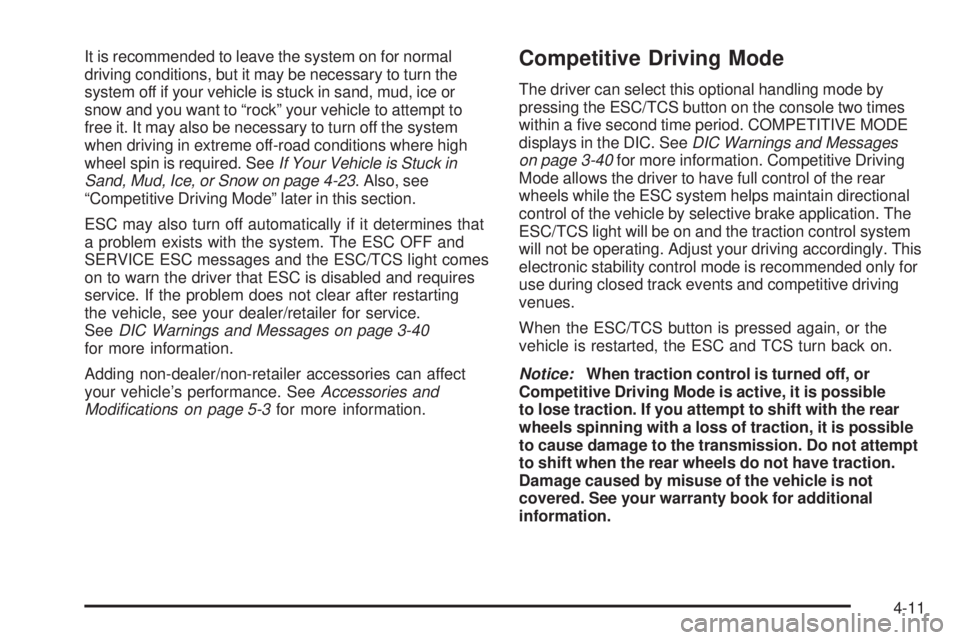
It is recommended to leave the system on for normal
driving conditions, but it may be necessary to turn the
system off if your vehicle is stuck in sand, mud, ice or
snow and you want to “rock” your vehicle to attempt to
free it. It may also be necessary to turn off the system
when driving in extreme off-road conditions where high
wheel spin is required. SeeIf Your Vehicle is Stuck in
Sand, Mud, Ice, or Snow on page 4-23. Also, see
“Competitive Driving Mode” later in this section.
ESC may also turn off automatically if it determines that
a problem exists with the system. The ESC OFF and
SERVICE ESC messages and the ESC/TCS light comes
on to warn the driver that ESC is disabled and requires
service. If the problem does not clear after restarting
the vehicle, see your dealer/retailer for service.
SeeDIC Warnings and Messages on page 3-40
for more information.
Adding non-dealer/non-retailer accessories can affect
your vehicle’s performance. SeeAccessories and
Modifications on page 5-3for more information.Competitive Driving Mode
The driver can select this optional handling mode by
pressing the ESC/TCS button on the console two times
within a �ve second time period. COMPETITIVE MODE
displays in the DIC. SeeDIC Warnings and Messages
on page 3-40for more information. Competitive Driving
Mode allows the driver to have full control of the rear
wheels while the ESC system helps maintain directional
control of the vehicle by selective brake application. The
ESC/TCS light will be on and the traction control system
will not be operating. Adjust your driving accordingly. This
electronic stability control mode is recommended only for
use during closed track events and competitive driving
venues.
When the ESC/TCS button is pressed again, or the
vehicle is restarted, the ESC and TCS turn back on.
Notice:When traction control is turned off, or
Competitive Driving Mode is active, it is possible
to lose traction. If you attempt to shift with the rear
wheels spinning with a loss of traction, it is possible
to cause damage to the transmission. Do not attempt
to shift when the rear wheels do not have traction.
Damage caused by misuse of the vehicle is not
covered. See your warranty book for additional
information.
4-11
Page 178 of 348
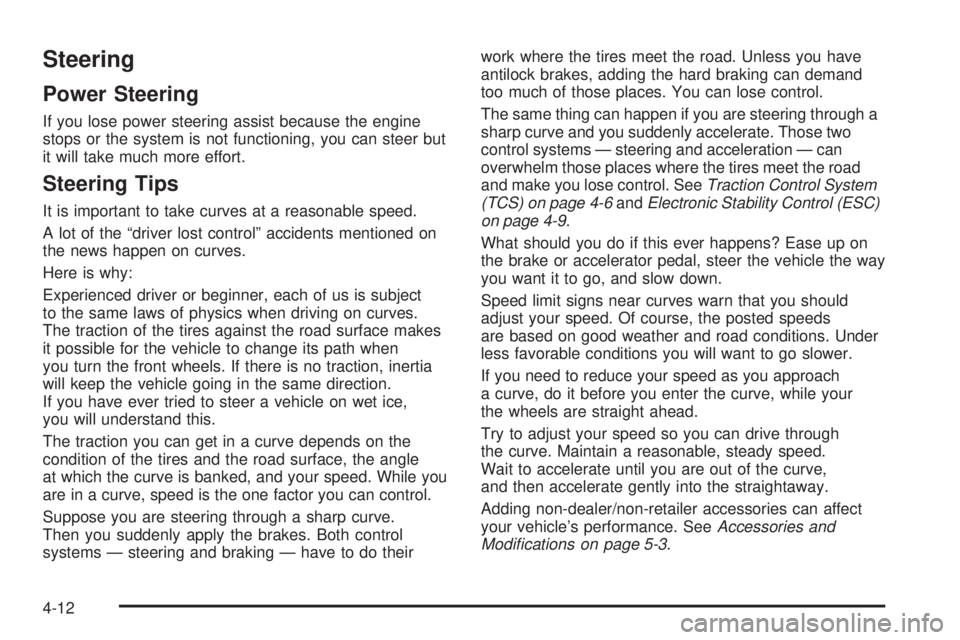
Steering
Power Steering
If you lose power steering assist because the engine
stops or the system is not functioning, you can steer but
it will take much more effort.
Steering Tips
It is important to take curves at a reasonable speed.
A lot of the “driver lost control” accidents mentioned on
the news happen on curves.
Here is why:
Experienced driver or beginner, each of us is subject
to the same laws of physics when driving on curves.
The traction of the tires against the road surface makes
it possible for the vehicle to change its path when
you turn the front wheels. If there is no traction, inertia
will keep the vehicle going in the same direction.
If you have ever tried to steer a vehicle on wet ice,
you will understand this.
The traction you can get in a curve depends on the
condition of the tires and the road surface, the angle
at which the curve is banked, and your speed. While you
are in a curve, speed is the one factor you can control.
Suppose you are steering through a sharp curve.
Then you suddenly apply the brakes. Both control
systems — steering and braking — have to do theirwork where the tires meet the road. Unless you have
antilock brakes, adding the hard braking can demand
too much of those places. You can lose control.
The same thing can happen if you are steering through a
sharp curve and you suddenly accelerate. Those two
control systems — steering and acceleration — can
overwhelm those places where the tires meet the road
and make you lose control. SeeTraction Control System
(TCS) on page 4-6andElectronic Stability Control (ESC)
on page 4-9.
What should you do if this ever happens? Ease up on
the brake or accelerator pedal, steer the vehicle the way
you want it to go, and slow down.
Speed limit signs near curves warn that you should
adjust your speed. Of course, the posted speeds
are based on good weather and road conditions. Under
less favorable conditions you will want to go slower.
If you need to reduce your speed as you approach
a curve, do it before you enter the curve, while your
the wheels are straight ahead.
Try to adjust your speed so you can drive through
the curve. Maintain a reasonable, steady speed.
Wait to accelerate until you are out of the curve,
and then accelerate gently into the straightaway.
Adding non-dealer/non-retailer accessories can affect
your vehicle’s performance. SeeAccessories and
Modifications on page 5-3.
4-12
Page 179 of 348
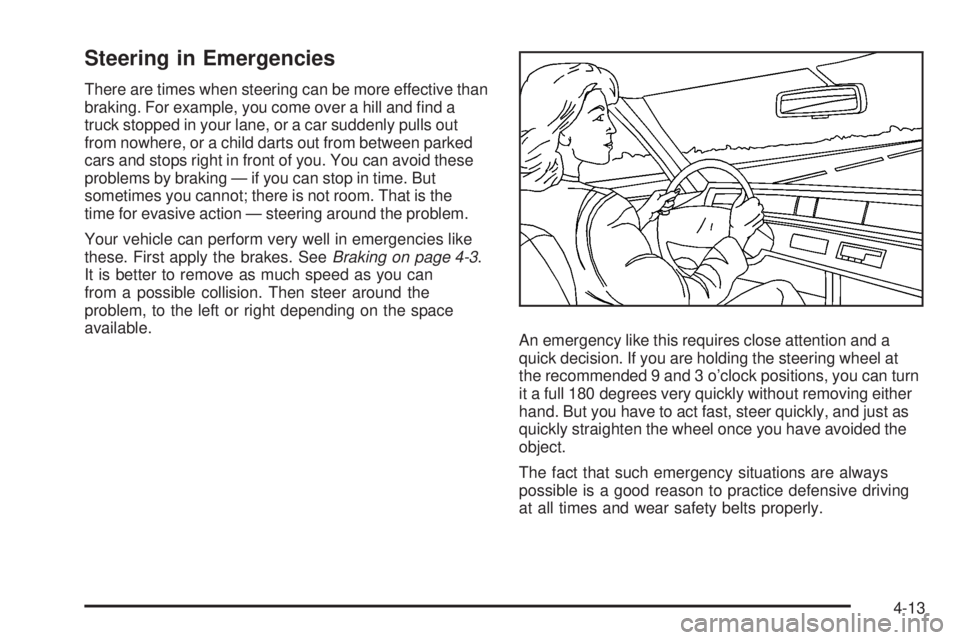
Steering in Emergencies
There are times when steering can be more effective than
braking. For example, you come over a hill and �nd a
truck stopped in your lane, or a car suddenly pulls out
from nowhere, or a child darts out from between parked
cars and stops right in front of you. You can avoid these
problems by braking — if you can stop in time. But
sometimes you cannot; there is not room. That is the
time for evasive action — steering around the problem.
Your vehicle can perform very well in emergencies like
these. First apply the brakes. SeeBraking on page 4-3.
It is better to remove as much speed as you can
from a possible collision. Then steer around the
problem, to the left or right depending on the space
available.
An emergency like this requires close attention and a
quick decision. If you are holding the steering wheel at
the recommended 9 and 3 o’clock positions, you can turn
it a full 180 degrees very quickly without removing either
hand. But you have to act fast, steer quickly, and just as
quickly straighten the wheel once you have avoided the
object.
The fact that such emergency situations are always
possible is a good reason to practice defensive driving
at all times and wear safety belts properly.
4-13
Page 180 of 348
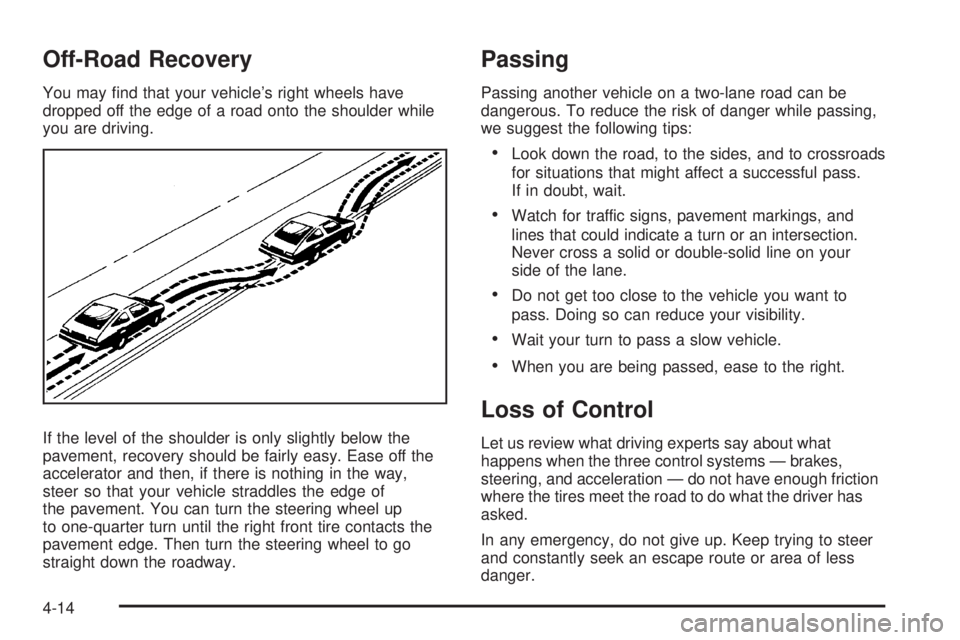
Off-Road Recovery
You may �nd that your vehicle’s right wheels have
dropped off the edge of a road onto the shoulder while
you are driving.
If the level of the shoulder is only slightly below the
pavement, recovery should be fairly easy. Ease off the
accelerator and then, if there is nothing in the way,
steer so that your vehicle straddles the edge of
the pavement. You can turn the steering wheel up
to one-quarter turn until the right front tire contacts the
pavement edge. Then turn the steering wheel to go
straight down the roadway.
Passing
Passing another vehicle on a two-lane road can be
dangerous. To reduce the risk of danger while passing,
we suggest the following tips:
Look down the road, to the sides, and to crossroads
for situations that might affect a successful pass.
If in doubt, wait.
Watch for traffic signs, pavement markings, and
lines that could indicate a turn or an intersection.
Never cross a solid or double-solid line on your
side of the lane.
Do not get too close to the vehicle you want to
pass. Doing so can reduce your visibility.
Wait your turn to pass a slow vehicle.
When you are being passed, ease to the right.
Loss of Control
Let us review what driving experts say about what
happens when the three control systems — brakes,
steering, and acceleration — do not have enough friction
where the tires meet the road to do what the driver has
asked.
In any emergency, do not give up. Keep trying to steer
and constantly seek an escape route or area of less
danger.
4-14